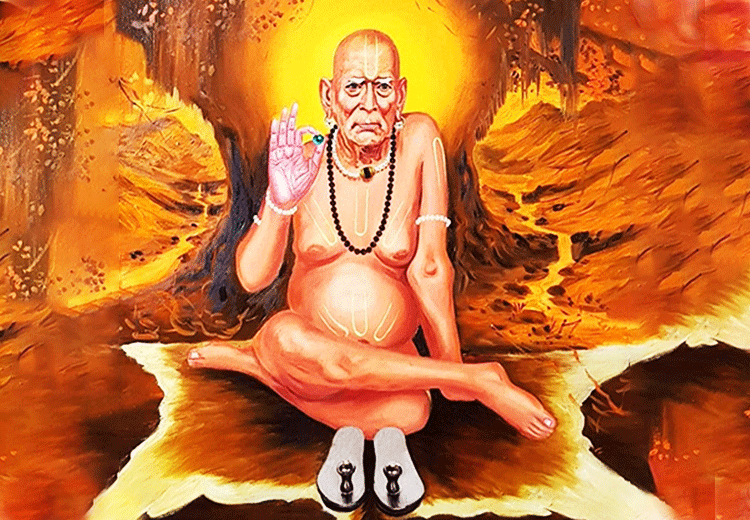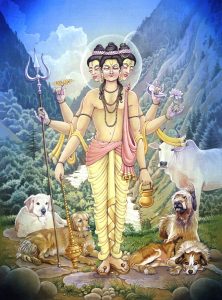
Of all the incarnations, Lord Dattatreya is considered to be the most superior because he is the combined form of all three deities Brahma, Vishnu and Mahesh. Akkalkotniwasi Shri Swami Samarth Maharaj was the incarnation of Lord Dattatreya.
In historic times, Shripaad Shrivallabh is believed to be the first incarnation of Shri Dattatreya. Shripaad Shrivallabh incarnated as Shri Nrisingh Saraswati, this way Shri Nrisingh Saraswati was the second incarnation of Shri Dattatreya. Shri Nrisingh Saraswati incarnated as Shri Swami Samarth.
In the 14th – 15th century, Shri Nrisingh Saraswati with his conduct diverted the Brahmins onto the path of truth.
He rid the lower section of society of their pain and trouble and got them on the path of devotion to the extent that he also influenced Muslims and rulers of those times. After completing his work in this form on earth, Shri Nrisingh Saraswatiji took samadhi in 1459 and then to Kardalivan.
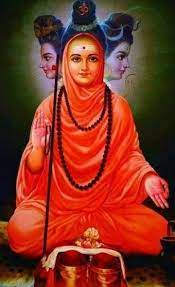
From Kardalivan, he went to a lonely jungle north of Bhagirathi and sat in meditation and penance. Because of unmoved meditation for a long time, an anthill came to being built on Shri Guru’s body and all his body was covered with this anthill. After 300 years of penance, one day, a woodcutter came there to cut wood. Just as he stroked with his hatchet it struck Guru’s thighs. Because of the blow of the hatchet, his thighs started bleeding. With this, Guru got up and ended his penance. The woodcutter was frightened but Shri Guru forgave him and manifested in the form of Swami Samarth. The mark of this hatchet was there on the thigh of Swami Samarth.
After this interruption, Shri Guru left for Gangotri post where he reached Devalgram. After instilling his footmarks there, he left for Rajur village in Marathawada where he built a monastery. Later he left the math and reached Udipi via Pandharpur in 1838. When he arrived at a place called Mangalvedha during this tour, he gained fame as “Chanchalbharti”. and some also used to call him “Digambar Swami”
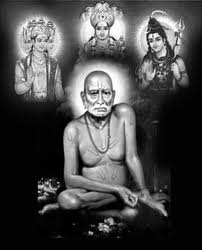
Shri Swamiji lived in Mangalvedha for around twelve years in solitude. If he ever came to the village, he would sit in a dirty place. Some called him Pagal Bua (mad person) and some Digambar Bua (naked person). But slowly and gradually people got impressed with his powers and started looking at him with devotion.
Once, he reached walking from Mangalvedha to a nearby village Mohol. After spending some time here, in 1854-55 he came to Solapur. Here, Chintopant Appa Tol became his devotee.
At Tol’s invitation, in 1856, Shri Swamiji came to Akkalkot and stayed there till the end. As he lived in Akkalkot till the end of his life, he became famous in the name of Akkalkot Swami or Akkalkotniwasi Shriswami Samarth Maharaj.
Shri Swami was a great ascetic with divine splendour. A divine light used to emanate that could not stare at him. He was fair with a long nose, huge body, broad chest and lotus-like feet. He always applied sandalwood paste on his forehead and arms. Shri Swamiji wore Kaupin (a small piece of cloth to cover private parts) and sometimes, he used to take this cloth off and moved around naked.
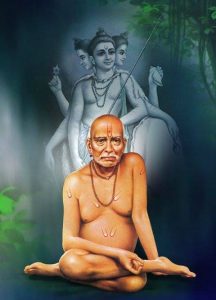
For Swamiji, there was no difference between earth and gold. Sometimes he would sleep on a mattress and sometimes on stone. He would ride on a horse or elephant with a parasol or sometimes sit on a heap of rubbish. Sometimes he would take bath many a times a day or sometimes would not take bath for days on end. Sometimes he would live in a palace and sometimes go to a temple and live there. He always remained engrossed in his world.
Shri Swamiji was an ocean of knowledge. Many great scholars’ egos used to break off in front of him. Just by keeping his hand over a mad child, he would make him speak Vedas, Upanishads and Gita. He strongly opposed casteism.
Normally, Swamiji spoke very less. Many a time he liked to keep mum. He spoke Marathi and also Sanskrit. He was very blunt in talking and showered bad words at times. Whether it was a rich man or a woman, he would bluntly speak in front of everyone.
As he was the incarnation of Lord Dattatreya, Swamiji had all the powers. He used to fill up dried well with water, cure the incurable disease within seconds, make a poor man rich immediately, and bring a dead person back to life. Swamiji performed infinite miracles during his life. Sometimes just for the sake of it or sometimes to favour his devotees. There is an infinite number of people living their life with his grace. Swamiji is the father of orphans, protection of the unprotected and strength of the weak.
Right from an ordinary man to Kings Swamiji had an infinite number of followers. The Kings who were his followers were the King of Akkalkot Maloji Raje, King of Gwalior Jayajirao Sindhiya, King of Indore Tukojirao Holkar and King of Baroda Malharrao Gayakwad etc.

Shri Swamiji had many great people as his disciple, to name the few- Shri Krishna Saraswati (Kumbhar Swami), Swami Nrisingh Saraswati of Alandi, Vamanbua Vamorikar or Badodekar, Gajanan Maharaj of Shegaon and Saibaba of Shirdi.
There was complete lustre, power and virtues of the lord in the incarnation of Shri Swamiji. It is difficult to describe these in words. One can only feel these with pure devotion.
After doing good to many of his followers, on the thirteenth day of the dark fortnight of Chaitra month in 1878, Shri Swami Samarth left for his heavenly abode. He kept on reciting Lord Shiva’s name eight days before his death. Every devotee who heard about his death ran to pay him last homage. Swamiji’s tomb was established at Chollapa’s house where Swamiji had once stayed at.
After his death also Shri Swamiji had given his darshan to many of his devotees and even today he gives them darshan. Apart from Akkalkot, Swamiji’s temples are there in many other places signifying that Swamiji is present in every place. It is only a matter of a devotee calling him- Swamiji graces his devotees everywhere and at all times.


